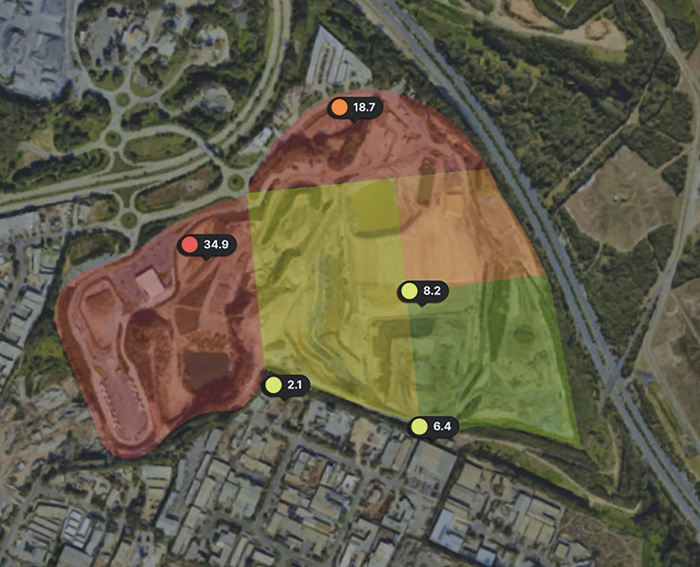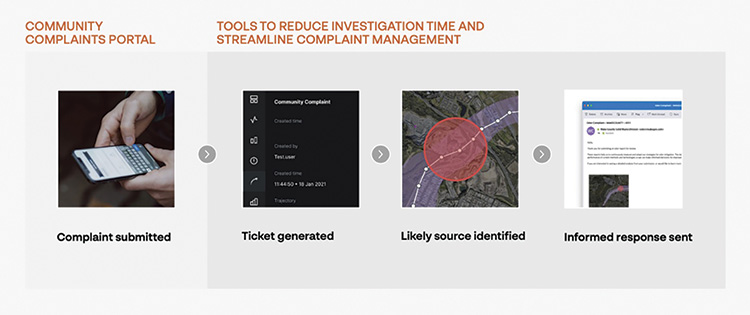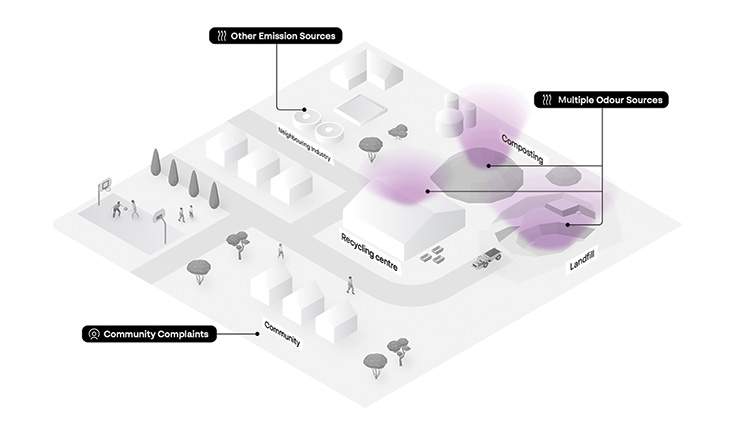Effective landfill odor control requires a comprehensive approach that involves regular monitoring, strategic planning, community engagement, and innovative technologies.
By Andres Quijano
Landfill sites are essential components of waste management in our communities, but they come with their own set of challenges, among which odor control stands out significantly. The production of unpleasant smells is a natural consequence of waste decomposition, primarily due to the breakdown of organic material by bacteria under both aerobic and anaerobic conditions.
This process releases a combination of gases, including methane, carbon dioxide, and a variety of volatile organic compounds (VOCs), which are often the main contributors to the notorious odors associated with landfills.
Tackling odor issues is challenging. It is difficult because it involves a complex interplay between quantitative sciences and people’s perceptions. Despite advances in technology and understanding, landfill odor issues will remain a challenge for a very long time. For environmental managers, understanding the composition and sources of these odors is the first step towards effective odor management strategies.

Images courtesy of Envirosuite.
Common Strategies for Landfill Odor Control Today
Identifying and mitigating the sources of landfill odors require a multifaceted approach. First and foremost, regular monitoring of landfill gas emissions is a crucial first step. This is normally achieved through the installation of landfill gas collection systems that not only help in capturing the gases for potential energy use, but also significantly reduce the emission of odorous compounds into the atmosphere.
However, small sensor technology has developed over the past few decades and has now become a viable part of the odor management mix. While they do not have particularly high accuracy, their great advantage is in providing far more data that can fill in a lot of the very large blanks spaces that have existed in the odor management problem.
Additionally, covering waste with soil or specialized membranes can minimize the exposure of decomposing waste to air, thus reducing odor generation. Another effective strategy involves the use of biofilters, which treat the collected gases by passing them through a medium inhabited by microorganisms that digest the odorous compounds.

How Does Odor Monitoring Data Help Inform Decision-Making?
Environmental managers must also consider the impact of weather conditions on odor dispersion and employ strategic planning to counteract these effects. Odor is something that we cannot see and has always been difficult and expensive to measure. This has been a barrier to effective management efforts in many cases.
Regular monitoring of landfill odors is essential not only for identifying the sources of odor emissions, but also for tracking the effectiveness of implemented management strategies. Advanced technologies such as remote sensors and drones can provide real-time data on odor emissions, helping environmental managers make informed decisions.
These tools can also be used to identify areas with a higher concentration of odorous gases, allowing for targeted mitigation efforts. Furthermore, long-term monitoring of odors can provide valuable insights into seasonal variations and changing weather patterns that may impact odor management.
In addition to monitoring, data analysis is also crucial in making informed decisions about odor control measures. By analyzing the composition and source of landfill gases, environmental managers can identify the most significant contributors to odors and develop effective mitigation strategies accordingly. This data can also be used in conjunction with odor complaint reports from the community to pinpoint specific areas or processes that require further attention.

What About Community Engagement Around Landfill Odor Control?
Another key factor has been the fact that much of the ‘measurement’ of an odor problem is from people in a neighboring community who might complain when it gets bad. Responding to landfill odor complaints is notoriously difficult. As a result, many odor problems are chronic, and communities become hostile about it.
Transparent community engagement is another critical component of effective odor management at landfill sites. Transparent communication with residents about the measures being taken to address odor concerns can foster a cooperative relationship. This involves regularly updating the community on the progress of odor mitigation efforts and the results of air quality monitoring.
Furthermore, providing a channel for residents to report odor complaints ensures that environmental managers can quickly identify and address new or escalating odor issues. By incorporating community feedback into the odor management strategy, landfill operators can not only improve the efficiency of their efforts, but also build trust and goodwill with the surrounding population.
Can Data Help Future Proof Landfill Design for Better Odor Control?
Landfill design plays a crucial role in managing odors. Modern landfills are designed with several layers of lining materials, including clay and synthetic liners, to prevent leachate from contaminating the surrounding soil and groundwater. These liners also help trap odorous gases, reducing their migration into the atmosphere. Additionally, proper compaction of waste can inhibit air flow and promote anaerobic conditions that minimize odor generation. Regular maintenance of landfill covers is also essential in preventing leakages and controlling odor emissions.
Effective landfill odor control requires a comprehensive approach that involves regular monitoring, strategic planning, community engagement, and innovative technologies. By understanding the sources of odors, using advanced tools for data collection and analysis, and improving landfill design, environmental managers can effectively mitigate odor issues and ensure a healthier environment for everyone.
It is essential to keep up with the latest advancements in odor management techniques to effectively tackle this ongoing challenge for landfill operators. With proper measures and community involvement, we can work towards minimizing the impact of landfills on our surroundings and continue to find sustainable solutions for waste management. | WA
Andres Quijano, Sales Manager – Americas, Envirosuite. He has more than 15 years of experience creating integrated hardware and software solutions that assist environmental professionals and site operators to optimize their management plans. His experience and passion for software has led him to design solutions that meet the most challenging environmental demands and constantly exceed customers’ expectations. Andres can be reached at [email protected]. For more information, visit https://envirosuite.com/industries/waste-management.
